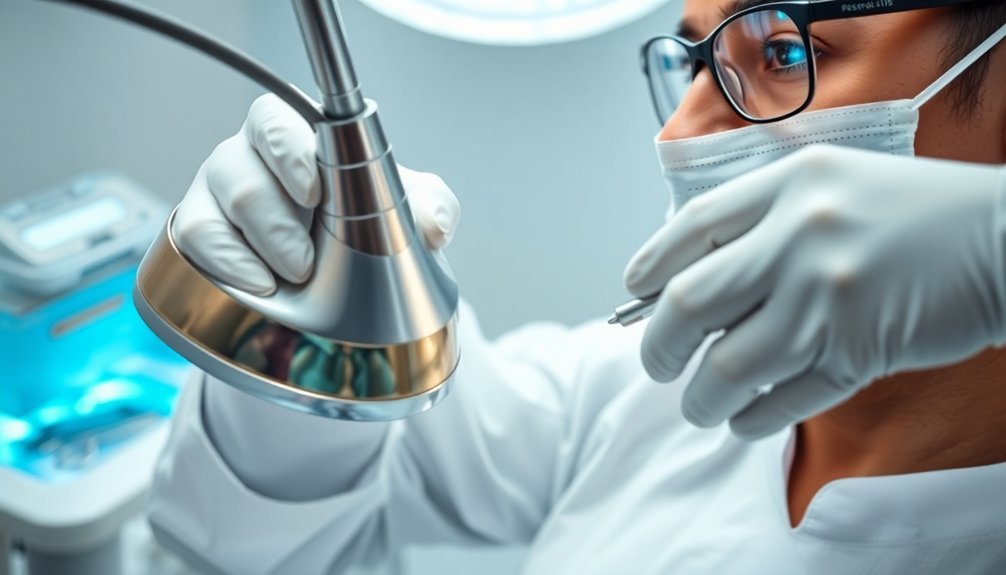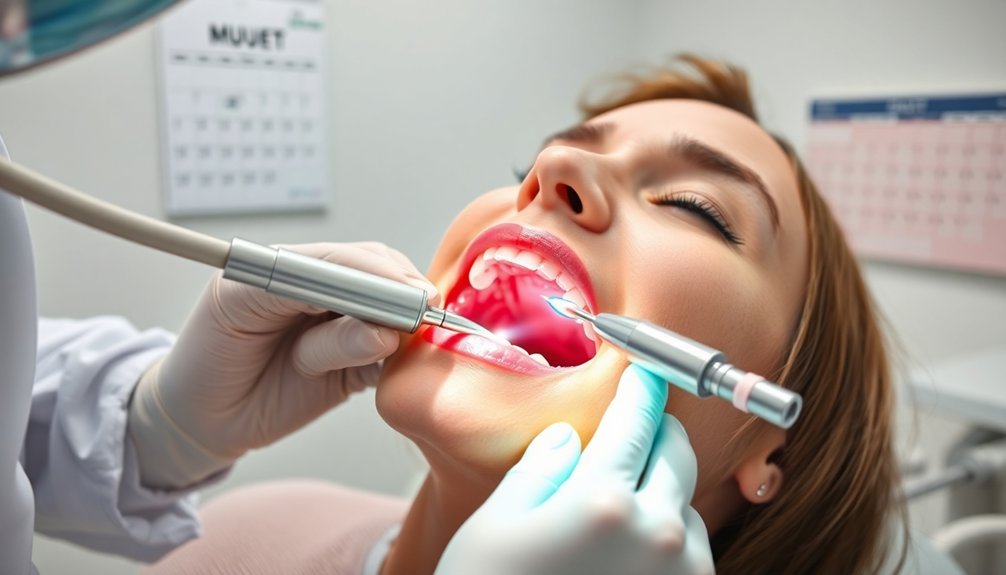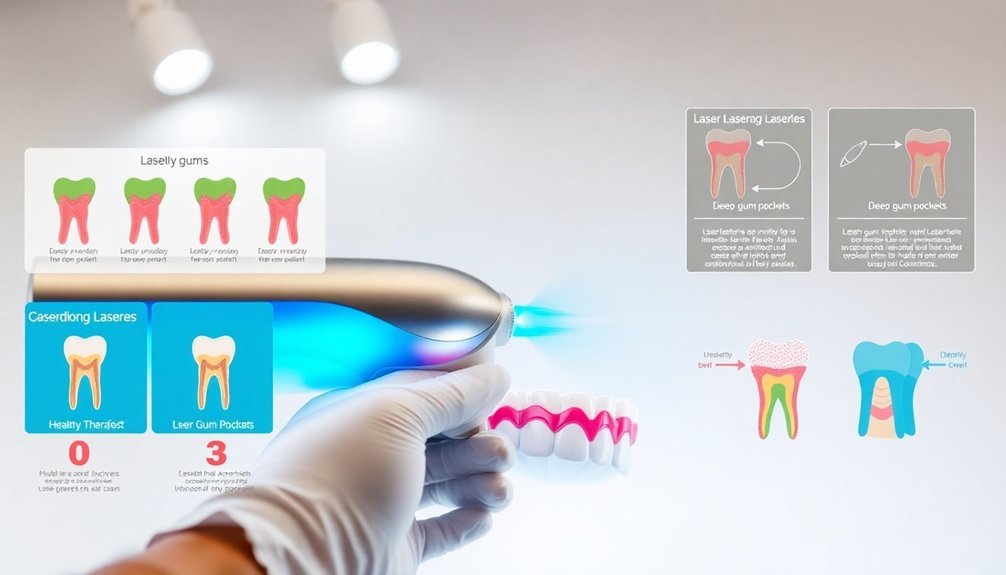When you consider laser therapy for deep gum pockets, focus on these three tips. First, understand the treatment process: it removes infected tissue precisely while preserving healthy areas. Next, prioritize post-treatment care to aid your healing—manage discomfort with over-the-counter pain relievers and stick to a gentle diet initially. Finally, schedule regular maintenance appointments to monitor your gum health and guarantee effective recovery. By following these steps, you'll enhance your treatment outcomes and enjoy lasting benefits for your oral health. You might discover even more valuable insights on optimizing your recovery and maintenance.
Understand the Laser Treatment Process

Understanding the laser treatment process is essential for anyone considering this innovative therapy for gum pockets. The procedure typically involves using diode lasers or Nd:YAG lasers, which are effective at targeting and removing only the infected tissue. This precision guarantees healthy tissue remains intact, minimizing damage. The thin laser tip can be easily inserted into gum pockets to evaporate harmful bacteria, considerably reducing counts of pathogens like Actinobacillus actinomycetemcomitans and Porphyromonas gingivalis.
Initially, the laser cleans out deep periodontal pockets, eliminating bacteria and infected tissue. Following this, scaling and root planing may occur, either with laser assistance or ultrasonic instruments.
After the cleanup, the laser is reapplied to stimulate blood flow, promoting the body's natural healing processes and forming a protective clot around the tooth roots. This enhanced precision of laser technology helps improve overall treatment outcomes and patient satisfaction.
Compared to traditional methods, laser therapy minimizes invasiveness, pain, and recovery time. It effectively reduces pocket depths and inflammation while facilitating gum reattachment.
Prioritize Post-Treatment Care
Post-treatment care is vital for ensuring a smooth recovery after laser therapy for gum pockets. Start by managing any discomfort—take Ibuprofen or Acetaminophen as directed for the first 24 hours. You may experience mild soreness, tooth sensitivity, and slight swelling for several days, so use over-the-counter anti-inflammatory medications as needed. If you encounter severe pain, contact your dentist promptly.
Next, maintain a gentle diet. Stick to liquids and soft foods for the first day, avoiding spicy dishes and any hard or crunchy snacks. Gradually introduce normal foods as you heal. Remember that during the healing process, the gums will tighten around teeth as part of your body's natural response.
Oral hygiene is important, too. Avoid brushing or flossing around the treated area immediately; instead, rinse with warm salt water every few hours for relief. After 24 hours, you can gently clean the area with a Q-tip dipped in an antimicrobial rinse.
Lastly, steer clear of irritants. Refrain from smoking for at least 48 hours, avoid using straws, and don't poke around the treated area with your tongue.
Following these guidelines will help you recover effectively and promote ideal healing.
Schedule Regular Maintenance Appointments

Scheduling regular maintenance appointments is essential for sustaining the benefits of laser therapy for gum pockets. These visits play a vital role in monitoring your gum health and guaranteeing that the improvements you've achieved continue. During these appointments, your dentist can track pocket depth, assess gum reattachment, and identify any new infections early, all of which prevent further damage. Most health care providers offer some coverage for LANAP treatment costs, which can help alleviate financial concerns related to ongoing care.
| Benefit | Description | Emotional Impact |
|---|---|---|
| Monitoring Pocket Depth | Keep tabs on your gum health progress | Peace of mind |
| Identifying Infections | Early detection of issues can save your smile | Relief from worry |
| Customized Cleaning | Tailored treatments target your specific needs | Personalized care |
| Long-Term Health | Guarantees lasting results from laser therapy | Confidence in your smile |
| Improving Home Care | Guidance on better oral hygiene practices | Empowerment to care better |
Frequently Asked Questions
What Are the Costs Associated With Laser Gum Therapy?
The costs for laser gum therapy typically range from $1,250 to $3,000 per quadrant, depending on gum disease severity. Insurance may cover a portion, considerably reducing your out-of-pocket expenses. Always consult your provider for specifics.
How Do I Know if I Need Laser Therapy?
You'll know if you need laser therapy if you notice swollen, bleeding gums or if your gum disease persists despite deep cleanings. A dental professional can evaluate your oral health and recommend appropriate treatment options.
Are There Any Specific Foods to Avoid Before Treatment?
Before treatment, there aren't specific foods you need to avoid, but it's wise to steer clear of anything that might irritate your gums. Maintaining good oral hygiene and nutrition is essential for ideal healing.
Can Laser Therapy Be Combined With Other Dental Procedures?
Yes, you can combine laser therapy with various dental procedures. This integration enhances treatment effectiveness, reduces discomfort, and often shortens recovery times, allowing for a more comfortable overall experience while preserving healthy tissue during treatment.
How Long Does the Laser Treatment Session Usually Take?
Laser treatment sessions usually take 2 to 3 hours. You'll typically have two sessions, treating one jaw at a time, with appointments scheduled 1 to 3 weeks apart for best results and healing.
In Summary
By understanding the laser treatment process, prioritizing post-treatment care, and scheduling regular maintenance appointments, you can effectively manage deep gum pockets and boost your oral health. Remember, your commitment to these steps not only promotes healing but also helps prevent future issues. Stay proactive, and don't hesitate to reach out to your dental professional for any questions or concerns. With the right approach, you're well on your way to healthier gums and a brighter smile!





Leave a Reply